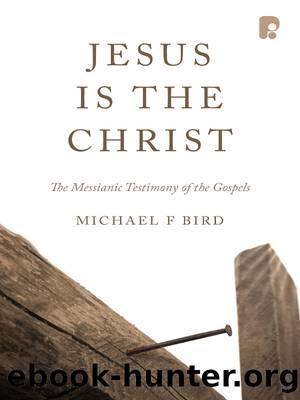Jesus Is the Christ: the Messianic Testimony of the Gospels by Bird Michael F.;

Author:Bird, Michael F.;
Language: eng
Format: epub
Tags: REL067040, book
ISBN: 4572978
Publisher: Authentic Media
Published: 2012-06-04T00:00:00+00:00
The Signs of the Messiah
Unlike Mark, appearance of the word occurs mainly in the first half of the Gospel of John (see 1:17,20,25,41; 3:28; 4:25,29; 7:26â27,31,41â42; 9:22; 10:24; 11:27; 12:34; the exceptions are 17:3; 20:31). By sheer linguistic statistics the âmessianic questionâ dominates the first half of the Gospel. Even so, in this section it is not simply titles that indicate who Jesus is, but it is also Jesusâ teachings, confrontations, interaction with others, tensions in the plot, Old Testament allusions, and internal dialogue among the crowd that provide pieces to the puzzle of who this elusive figure is. This first half of the Gospel, John 1 â 12, is often called the Book of Signs. In this section, specifically 1:19 â 12:50, Jesusâ miracles and encounters with several persons demonstrate his messianic work and validate his unity with the Father. The âsignsâ function as an additional witness alongside John the Baptist and the Scriptures to indicate Jesusâ unique role as Godâs agent of revelation and salvation (5:31â47). The purpose of these signs is to explicate Jesusâ identity as the heaven-sent Messiah who reveals the Fatherâs glory.18 Unlike Jesusâ mighty deeds in the Synoptic Gospels, which are primarily demonstrations of the in-breaking kingdom, the signs in the Fourth Gospel contain a heightened christological focus. The signs foster division over Jesusâ person as they demand a response of either faith or rejection. At a crucial point the people in the crowd ask of themselves, âWhen the Messiah comes, will he perform more signs than this man?â (7:31). The âsignsâ are analogous to Matthewâs âdeeds of the Messiahâ (Matt. 11:2), in that the Johannine signs bring a crisis of messianic belief in the audience, in Jesusâ own day and among Johnâs contemporaries, as the work of Jesus forces individuals to decide who he is.
Could this be the Messiah? (John 1:19â51)
John 1:19â51 constitutes a prelude to Jesusâ public ministry that features the witness of the Baptist (1:19â34) and the calling of the first disciples (1:35â51). Importantly both subsections hinge on Jesusâ messianic identity, which is the core of the Baptistâs testimony, and the amazing news that magnetically attracts the disciples to Jesus. In this section we find the beginning of the âQuest for the Messiahâ, which starts with John pointing his interlocutors to Jesus, whom the disciples soon find.19
The Baptist was explicitly nominated as a marturi/a (âwitnessâ) to Jesus in the prologue (1:7) and now he undertakes to flesh out that witness further. When confronted with a delegation of Jerusalem priests and Levites concerned to know who he is, the Baptist immediately responds, âI am not the Messiahâ (1:20). The Messiah here is the royal Davidic Messiah as he is elsewhere in the Gospel (see John 7:42). The Baptist also denies being âthe Prophetâ or âElijahâ (1:21). The âProphetâ is obviously the eschatological prophet like Moses (Deut. 18:15â19), and the evangelist also believes that this designation is true of Jesus, not the Baptist (4:19; esp. 6:14; 7:40,52; 9:17). The expectation of the return of the prophet Elijah is based on Mal.
Download
This site does not store any files on its server. We only index and link to content provided by other sites. Please contact the content providers to delete copyright contents if any and email us, we'll remove relevant links or contents immediately.
The Five People You Meet in Heaven by Mitch Albom(3335)
Real Sex by Lauren F. Winner(2861)
Name Book, The: Over 10,000 Names--Their Meanings, Origins, and Spiritual Significance by Astoria Dorothy(2836)
The Holy Spirit by Billy Graham(2775)
The Secret Power of Speaking God's Word by Joyce Meyer(2750)
ESV Study Bible by Crossway(2668)
How The Mind Works by Steven Pinker(2612)
0041152001443424520 .pdf by Unknown(2594)
Ancient Worlds by Michael Scott(2493)
The ESV Study Bible by Crossway Bibles(2412)
The Gnostic Gospels by Pagels Elaine(2393)
The Meaning of the Library by unknow(2385)
Churchill by Paul Johnson(2364)
MOSES THE EGYPTIAN by Jan Assmann(2275)
City of Stairs by Robert Jackson Bennett(2226)
Jesus by Paul Johnson(2224)
The Complete Dead Sea Scrolls in English (7th Edition) (Penguin Classics) by Geza Vermes(2135)
Ancient Near Eastern Thought and the Old Testament by John H. Walton(2130)
The Nativity by Geza Vermes(2113)
